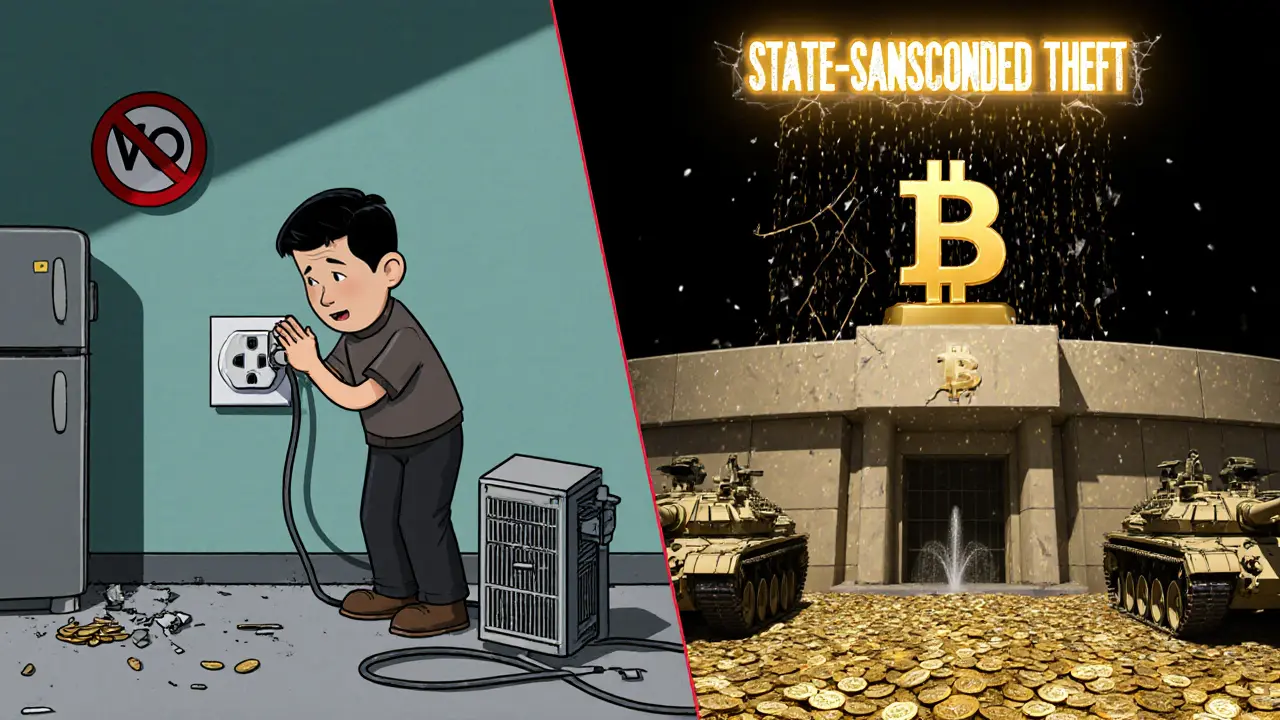 Nov, 14 2025
Nov, 14 2025
Iran Energy Theft Calculator
How Much Electricity Are IRGC Mining Operations Using?
The IRGC controls most of Iran's crypto mining infrastructure. Calculate how this electricity use impacts ordinary citizens.
When Iran’s lights go out in the middle of winter, families huddle under blankets while factories shut down. But in hidden military zones, thousands of powerful computers hum nonstop-mining Bitcoin, consuming more electricity than entire cities. This isn’t illegal because it’s hidden. It’s illegal because it’s state-sanctioned.
The Energy Theft Behind Iran’s Blackouts
Iran’s power grid is collapsing. Cities like Tehran, Isfahan, and Mashhad face daily outages lasting 8 to 12 hours. Hospitals use backup generators. Schools cancel classes. But while civilians struggle, massive mining farms run 24/7-powered by electricity meant for homes and businesses. These aren’t basement operations run by hobbyists. They’re industrial-scale facilities, each with tens of thousands of ASIC miners, clustered inside IRGC-controlled zones. One known site in Rafsanjan, Kerman Province, alone draws 175 megawatts-enough to power a medium-sized European country. That’s not a typo. One farm. One location. Enough to light up 150,000 homes. The cost? Iranian citizens pay for it. Literally. The government subsidizes electricity at less than 1 cent per kilowatt-hour. But private miners? They’re forced to pay 10 times that. Meanwhile, IRGC-linked operations don’t pay at all. They just take it. Energy Minister Ali Abadi, a former IRGC commander, called this theft “an ugly and unpleasant act.” But his past makes it clear: this isn’t corruption. It’s policy.How the IRGC Built a Crypto Cartel
In 2019, Iran officially legalized cryptocurrency mining. On paper, it looked like reform. In reality, it was a takeover. The Ministry of Industry, Mines, and Trade issued licenses-but only to those who agreed to sell all mined coins to the Central Bank of Iran at fixed, below-market rates. Private miners couldn’t keep profits. They couldn’t even cash out easily. The rules were designed to kill competition. The IRGC didn’t need a license. They didn’t need permission. They had power. By 2020, IRGC-affiliated entities-like Astan Quds Razavi, a massive religious foundation directly under Supreme Leader Khamenei-began building mining farms inside military bases and special economic zones. These locations are off-limits to inspectors. No audits. No bills. No oversight. They partnered with Chinese firms to import mining hardware. They built private power lines to bypass the national grid. They even got parliamentary approval in 2022 to construct their own electricity plants. The goal? Total control over the entire supply chain: hardware, power, and crypto. Estimates suggest 180,000 mining devices operate in Iran. About 100,000 of them belong to the IRGC or its proxies. That’s more than half the country’s mining power-controlled by a single military organization.
Crypto as a Sanctions-Busting Tool
Iran’s economy has been under heavy sanctions since 2018. Banks can’t receive dollars. Companies can’t trade internationally. The rial collapsed. The regime needed a way out. Cryptocurrency became the answer. Unlike bank transfers, Bitcoin transactions don’t need SWIFT. They don’t require intermediaries. They leave no paper trail. A single wallet can receive millions in crypto from anywhere in the world-and convert it into cash through local exchanges. U.S. Treasury and Israeli intelligence have tracked Bitcoin wallets tied directly to IRGC operations. Funds from these wallets have flowed to Hezbollah in Lebanon, to Houthi rebels in Yemen, to militias in Syria. Crypto mining isn’t just about profit. It’s about survival. The IRGC doesn’t mine Bitcoin to get rich. They mine it to fund war.Two Systems, One Country
There are two Irans when it comes to crypto mining. One is the official version: licensed miners who pay high electricity rates, sell coins to the central bank, and risk arrest if they try to sell outside the system. Many have quit. Others operate in the shadows, using VPNs to access foreign exchanges like Nobitex. The other is the IRGC version: no bills, no rules, no consequences. They control the power. They control the hardware. They control the flow of money. This isn’t a loophole. It’s a hierarchy. The state doesn’t crack down on unlicensed mining. It *is* the unlicensed mining. Even when the Central Bank blocked all crypto-to-rial transactions in late 2024, they didn’t shut down mining. They just moved it behind their own API. By January 2025, they began selectively unblocking exchanges-only if they gave the government full access to user data. Control, not elimination, is the goal.
The Human Cost
In the city of Kermanshah, a factory owner told a local journalist his machines shut down three days a week because the grid couldn’t handle demand. His workers got paid half their wages. He couldn’t afford to buy diesel for his generator. Meanwhile, just 30 kilometers away, an IRGC mining farm ran full tilt. No outages. No limits. Just noise, heat, and electricity flowing from the grid they never paid for. Children study by candlelight. Elderly people can’t use oxygen machines. Hospitals cancel surgeries. All because a military organization decided that mining Bitcoin was more important than keeping the lights on. The world talks about crypto as a tool for freedom. In Iran, it’s a weapon of control.What’s Next?
Iran’s crypto mining industry isn’t shrinking. It’s growing. New mining zones are being built near oil fields, where excess natural gas can be burned to generate cheap power. The IRGC is even experimenting with solar-powered farms in desert regions. The Central Bank is pushing for a state-controlled digital currency, which would give them even more power to track and restrict financial activity. Meanwhile, ordinary Iranians keep using VPNs, peer-to-peer trades, and underground exchanges to survive. But they’re not mining. They’re not profiting. They’re just trying to get by. The system isn’t broken. It’s working exactly as designed.Is cryptocurrency mining legal in Iran?
Technically, yes-but only under strict government control. The Iranian government legalized mining in 2019, but only for those who sell their coins to the Central Bank and pay high electricity rates. In practice, only IRGC-linked entities operate without these restrictions. Most private miners are forced underground or shut down entirely.
Who controls most of Iran’s crypto mining?
The Islamic Revolutionary Guard Corps (IRGC) and affiliated organizations like Astan Quds Razavi control an estimated 50-60% of all mining hardware in Iran. These groups operate in military zones with direct access to subsidized electricity, no regulatory oversight, and armed protection. Private miners make up the rest, but they face high costs and heavy restrictions.
Why does Iran allow crypto mining if it causes blackouts?
Because the government doesn’t see it as a problem-it sees it as a solution. Crypto mining helps Iran bypass international sanctions by generating hard currency outside the traditional banking system. The IRGC uses the profits to fund proxy groups, import banned goods, and stabilize the regime. The blackouts are a side effect, not a failure.
Can regular Iranians profit from crypto mining?
It’s nearly impossible. Private miners must pay high electricity rates and sell their coins to the Central Bank at fixed, low prices. They’re also blocked from using domestic banking systems to convert crypto to rials. Most who try use VPNs to access foreign exchanges, but that’s risky and technically complex. The system is designed to favor state actors, not citizens.
How does Iran’s crypto mining compare to other countries?
Iran is now one of the world’s top 10 Bitcoin producers. Unlike the U.S. or Kazakhstan, where mining is mostly private and regulated, Iran’s industry is dominated by a single military entity using state resources. The scale is smaller than China’s pre-ban operations, but the level of state control and energy theft is unmatched. No other country uses crypto mining as a sanctioned tool of sanctions evasion and military funding.